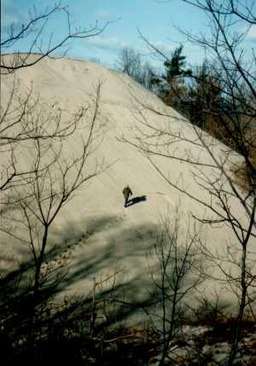Mount Baldy (sand dune)
| Mount Baldy | |
|---|---|
 View of the dune | |
 Location of Mount Baldy in Indiana | |
| Coordinates | 41°42′32″N 86°55′41″W / 41.7089°N 86.9281°WCoordinates: 41°42′32″N 86°55′41″W / 41.7089°N 86.9281°W |
| Range | 41°42'33"N 86°55'47"W |
| Elevation | 126 feet (38 m) |
| Age | Holocene |
Mount Baldy is a sand dune located in the Indiana Dunes National Lakeshore. It is on the southern shore of Lake Michigan and is 126 feet tall. It is a wandering dune that moves or shifts every year, and is called a "living dune."
Mount Baldy is accessible from U.S. Route 12 (also known as Dunes Highway) between the town of Pines and the western border of Michigan City, Indiana. It is a tourist attraction locally and regionally, drawing weekend and summer visitors from Chicago. Prior to the dune's closure, on a clear day one could see Chicago's skyline from its top. North of Mount Baldy is a swimmable beach which is also part of the Indiana Dunes National Lakeshore.
Erosion
Due to its popularity with visitors, the marram grass which had stabilized the dune was largely destroyed, and the dune has begun advancing southwards, threatening to overrun its parking lot. Accordingly, the National Park Service has rerouted trails and planted grass in hopes of slowing the dune.
The piers from nearby Michigan City, Indiana intensify erosion by blocking the natural sediment flow produced by longshore drift in Lake Michigan.
Human-induced climate change is resulting in additional erosion of the lake's coast. With warmer and shorter winters, there are less days that shelf ice is present to protect the shore from winter storm erosion.
Decomposition Chimney
In 2013, a void space anomaly in the dune led to a small child falling into a cylindrical shaft that collapsed and buried the child. It took three hours for the boy to be rescued from the 11-foot (3.4 m) pit. The geological process that is producing the never before studied anomalies appears to be related to the burial and decomposition of fungus-ridden black oak trees.[1] In 2016, scientists concluded that such anomalies in the moving or living dune are caused by the burial of trees that eventually decay leaving a hollowed out shaft beneath unsteady ground, named a "dune decomposition chimney." The majority of the dune remains closed to visitors except on ranger-led tours, however, the beach reopened in the summer of 2017.[2][3]
References
- ↑ Wei-Haas, Maya. "New Insights Behind the Sand Dunes That Swallowed a Boy". Smithsonian.com. Smithsonian Magazine. Retrieved 6 November 2015.
- ↑ "Chicago Tribune". My.chicagotribune.com. Retrieved 1 August 2018.
- ↑ Lavalley, Amy. "Mount Baldy remains closed; researchers closer to finding sand answers". Chicagotribune.com. Retrieved 1 August 2018.